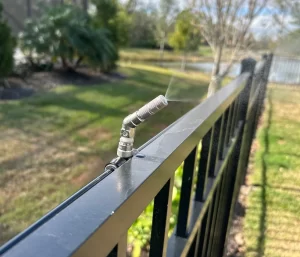How Misting Systems Work
Most mosquito misting systems use insecticides such as permethrin or natural pyrethrins, derived from chrysanthemum flowers. These substances affect the mosquito’s nervous system, quickly reducing their numbers in treated areas.
Some systems also allow for natural or green alternatives, such as those containing essential oils or sodium lauryl sulfate, which act more as repellents than killers. While effective, these natural formulas often require more frequent application and careful consideration of their effects on surfaces, as some oils can degrade plastic materials or fail to mix well in the misting drum.
What Does a Mosquito Misting System Look Like?
Videos of Mosquito Misting Systems
Benefits of Automated Operation
Because the system is automatic, it offers convenience and consistency in pest control without requiring constant user intervention. Users can program cycles based on pest activity or specific needs, such as before a gathering or during periods of heavy mosquito presence.
This approach reduces reliance on manual sprays or temporary fogging services, providing long-term control and comfort in outdoor spaces.
What Are The Benefits of a Mosquito Misting System?
Maintenance Requirements
Misting systems are low maintenance and long-lasting. Routine upkeep includes checking the misting fluid levels, replacing filters, cleaning or adjusting nozzles, and preparing the system for winter in colder climates.
Homeowners can perform basic maintenance or hire professionals for service and seasonal readiness.
Safety Considerations for Pets and Families
Safety is an important concern, especially for families with pets. According to the U.S. Environmental Protection Agency (EPA), misting systems using approved insecticides—when operated according to labeled instructions—pose minimal risk to humans and animals.
However, caution is still advised. Dogs typically tolerate pyrethroids well, while cats and aquatic animals are more sensitive. For pet owners, natural formulations or careful scheduling of spray cycles can help minimize exposure.
Spider Control with Misting Systems
In addition to mosquito control, misting systems can also target spiders and other pests. By placing nozzles in areas like eaves, docks, and storage sheds—where spiders build webs—the system helps reduce infestations and cleanup needs. Spider misting cycles are often shorter and more frequent than mosquito cycles, with a focus on hitting target areas during the night when spiders are most active.
How Misting Differs from Fogging
Mosquito misting systems differ from fogging services in that they offer continuous, on-demand control, while fogging is performed by municipalities or pest control companies at fixed intervals.
Unlike fogging, which relies on truck routes and may not reach private backyards effectively, misting systems provide direct, tailored protection for a specific property.
Installation and Cost Overview
Installation of a mosquito misting system typically involves a one-time setup cost, including the unit, nozzles, tubing, and labor. Long-term costs include refilling the insecticide solution and occasional part replacements.
Though upfront costs may be higher than periodic spraying services, the consistent and hands-off operation often provides greater value over time.
Choosing Natural or Organic Misting Solutions
Homeowners considering natural or organic insecticides should review product labels closely. The EPA’s “minimum risk pesticides” category includes ingredients like clove oil, castor oil, and wintergreen. While safe for the environment, these substances may not be suitable for every yard, especially if they damage plastic surfaces or fail to deliver consistent misting results. Water-based formulations with sodium lauryl sulfate or low concentrations of essential oils tend to offer a better balance between safety and performance.
Ideal for High-Risk Areas
Misting systems are especially beneficial in areas with standing water, such as lakes, ponds, or swamps—prime mosquito breeding grounds. Because mosquitoes can travel up to three miles, homeowners near such areas are at a greater risk and can benefit more from the round-the-clock protection a misting system provides.
A Smart Solution for Outdoor Living
Finally, mosquito misting systems are ideal for people who spend a lot of time outside, entertain guests, or simply want to make the most of their patios, gardens, and yards. With programmable settings, invisible nozzles, and flexible misting schedules, these systems let users take back control of their outdoor environment—comfortably and effectively.








